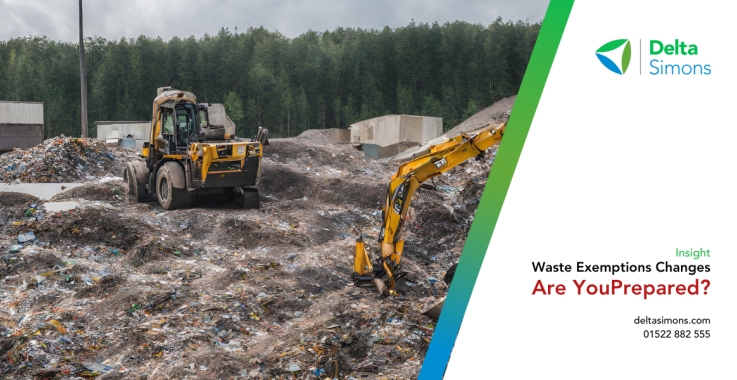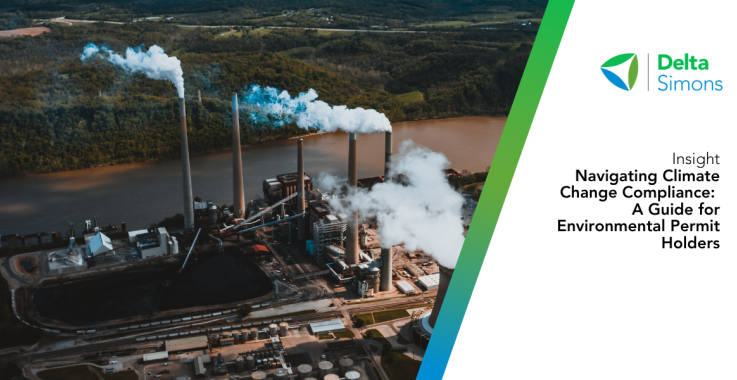Building Resilient Portfolios: Navigating Flood Risk and Climate Change for Sustainable Real Estate Investment
05 Jan 2023
Environmental Planning
Water Services
Due Diligence
Environmental Transaction Services
According to the Environment Agency, since 1998 we have seen six of the ten wettest years on record. In 2022, for the first time ever, we saw three named storms in one week.
One of the key messages coming from COP27, is that we must plan and prepare for increasingly extreme weather events. To help our clients prepare and build portfolios resilient to flooding, Associate Water Services Consultant, Alex Perryman, and Environmental Transactions Services Unit Director, Graham Duffield hosted a free CPD webinar. In our latest insight, Alex Perryman answers our clients' most frequently asked questions and the key takeaways for investors who have suffered from or are concerned about their portfolio's resilience to flooding both now and in the future as a result of climate change.
The World Economic Forum published an updated flood risk analysis in the Nature Communications Journal in September 2022, stating that 23% of the world population (1.81 billion people), currently faces significant flood risk.
The devastating floods in Western Europe in 2021, killed over 200 people and were listed as one of the top 10 biggest natural disasters worldwide by economic damage from 1980 to July 2022 (Statistia 2022).
“Under optimistic climate change scenarios (RCP 2.6), sea levels are estimated to rise up to 0.55 m by 2100, putting especially large coastal cities at risk.” - Flood exposure and poverty in 188 countries, Nature Communications Journal.
By the year 2030, the Global Assessment Report (GAR 2022), published by the United Nations Office for Disaster Risk Reduction (UNDRR), estimate that there will be 560 climate-related disasters per year, globally.
As the number of climate-related disasters increases, so does the economic cost to businesses. With an average cost of $170 billion per year across the world during the past decade, and the number of climate-related disasters predicted to continue to rise, investors must invest and adapt to be flood risk and climate resilient, mitigate and adapt to extreme weather events.
2023 will see the disclosure of climate-related risks become mandatory for investors and their portfolios of assets through frameworks such as The Task Force on Climate-Related Financial Disclosures (TCFD). It is time now to act and build climate and flood-resilient portfolios that build value for your next divestment/investment cycle.
Why is flood risk and climate change important in real estate investment?
As investors, you want to safeguard your assets from future risks such as increased flood risk caused by climate change by safeguarding your assets. This will lessen the risk of your assets devaluing over time or the inability to sell an asset as a result of climate change.
They may also be CapEx implications to provide flood and climate-resilient measures or increasing challenges in the ability to obtain insurance at commercially acceptable rates, especially if it cannot be demonstrated that your assets are flood or climate resilient.
Under initiatives such as the EU Taxonomy (expected to be reflected in the UK Green Taxonomy) and through others such as The Task Force on Climate-Related Financial Disclosures (TCFD) and Taskforce on Nature-related Financial Disclosures (TCND) there are a range of drivers for sustainable construction.
We need to better understand what are the main drivers in order to understand what is required to safeguard your assets.
What Are The Main Drivers Behind Effectively Managing Flood Risk?
The main driver is the TCFD. The TCFD breaks down risks into Physical and Transitional Climate Risks, in which ‘flood risk’ clearly falls into the Physical Risk category. Other physical risks include acute event-driven risks such as drought, floods, extreme precipitation and wildfires or chronic long-term climate risks such as rising temperatures and sea-level and accelerating loss of biodiversity etc.
The TCFD is a framework, formed by the Financial Stability Board to help identify the information needed by investors, lenders and insurance underwriters to appropriately assess price, and disclose climate-related risks and opportunities over the short, medium and long term.
The TCFD is the go-to ESG reporting framework for investors and ultimately helps companies develop an overarching ESG strategy.
The TCFD is currently voluntary, but it is due to become a mandatory requirement next year in 2023. The exact date is yet to be confirmed, which is why our investor clients are asking questions about climate change and flood risks in relation to their current Assets Under Management (AUMs).
EU Taxonomy
We are at a stage now where it is a reasonable assumption that much of the world will feel the implications of the EU Taxonomy (and the Green UK Taxonomy if implemented).
EU Taxonomy works on two principles;
- Do no significant harm - 70% of materials on site, not including hazardous materials, must be retained, reused or recycled.
- Make significant contribution - yet to be defined
Most companies throughout the world have at least started to think about their sustainability journey with many making progress towards sustainable goals.
Under the EU Taxonomy, contributions towards the climate change adaptation objective require some companies to make an assessment of physical climate risks which have the potential to impact the company and its facilities. Our Delta Simon's reports are used by our clients to inform EU Taxonomy alignment as well as TCFD disclosures as part of a joined-up approach. It's not mandatory for all, but for some companies, seeking to align to the EU Taxonomy is part of their best practice.
The TCFD breaks down risks into two; physical climate risks and transitional climate risks.
Physical risks can include acute event-driven risks such as drought, floods, wildfires, extreme precipitation, etcetera or chronic long-term climate risks such as rising temperature and sea levels. Flood risk falls into the physical risk category.
Our wider Delta Simon's team can assess physical risks as well as transitional risks arising from changes in policy and new technologies such as the growth of renewable energy, as well as support with ESG assessment and advice.
Value At Risk (VAR)
Another key driver for effectively managing flood and other physical risks is the Value At Risk (VAR), the measure of an asset or portfolio of assets.
With an increase in flood risk as a result of climate change and without flood and climate-resilient measures implemented over time, there is a real risk of devaluation of an asset or portfolio of assets. Furthermore, there could be operational disruption or additional salability and insurance challenges.
To reduce the potential financial risks, implementing a series of measures to reduce potential risk, including the installation or retrofitting of flood and climate-resistant and resilient measures, is essential. Such measures include floodproof doors, window shutters, raising, and relocating sensitive equipment, use of floodproof building materials, etc.
These kinds of resilience measures can be effective in mitigating flood risk up to 0.6 metres in depth. Anything exceeding 0.6 metres requires a Water Entry Strategy.
If your site is considered to be at risk, it is imperative that flood warning measures and response plans are prepared to ensure business continuity, safe emergency and evacuation and a clearly defined set of approaches and set of responsibilities.
Clearly, there will be a cost to install these measures, therefore there are potential CapEx implications to ensure there is a return on investment for any upgrades or improvements to your physical assets.
CapEx can also be undertaken on any new opportunities to ensure the risks are appropriately assessed and that mitigation is accounted for which ultimately helps your decision-making in terms of whether to keep/buy or sell an asset.
What are the potential flood risk impacts?
When considering investment, there are potentially significant impacts that could arise if flood risk is not considered early on in the decision-making process.
For example, sea level rise and increasing the severity of extreme weather events may financially impact operations. Increased temperatures result in melting ice. Sea water expansion leads to global sea level rise. Rising sea levels can result in increased tidal flooding, operational disruption and economic damage to assets that are in coastal locations. All of these impacts have the ability to derail or change an investment decision.
As climate changes become more severe, potential investment sites in Flood Zone 1 could be at risk in the future, increasing the need for those flood and climate resilience measures.
Physical risks are largely measured through Representative Concentration Pathways (RCPs) adopted by the Intergovernmental Panel on Climate Change (IPCC).
RCP’s relate to Greenhouse Gas (GHG) emissions and trajectories. By assessing temperature changes we can assess the physical risks to an asset.
The main RCP’s assessed are RCP2.6, RCP4.5/RCP 6.0 and RCP8.5. Think of it as grading from best case through to worst case scenario, a little like the EA’s Flood Zones 1, 2 and 3. The ‘global’ IPCC climate data is carried through to the UK’s Climate Projections (UKCP18) ‘local’ data in which UK assets can be assessed.
A key takeaway point is that investors are required to assess two RCP scenarios of which one is the RCP2.6 and the other is depending on your requirements. Delta-Simons can help you with this stage. I tend to look at the RCP8.5 worst-case scenario and the 2100 extreme timeframe. If your assets are not at risk in this scenario your assets are considered protected from CC. If there is a level of flood risk we can then conduct a deeper dive into the other RCP’s scenarios.
Data Gaps and Challenges
Our team use all available and relevant flood risk and climate change information. However, there are limitations, assumptions, data gaps and challenges between the various datasets and portals etc. These include, but are not limited to;
- Environmental Agency (EA) data takes a statutory 20 working days to obtain - We recommend that EA Product data is obtained as it includes flood depth and CC data which can be compared with the local UKCP18 climate data to work out what is most representative. Without detailed EA data there is no direct or easy comparison with UKCP18 data.
- EA data does not assess all the various RCP’s and time periods - Flood Zones closest correlate with the RCP8.5 2100 scenario.
- EA data vary in model coverage, quality, and accuracy - they do not always clearly separate fluvial and tidal interactions.
- Disconnect in terminology - The EA works around return periods (1 in 100 year flood event) whilst climate data revolves around RCP’s.
- Lack of modelled flood and climate data across Europe - The EA is playing catch up in order to better align and provide more transparency on their internal mechanisms of their data and allow better comparison with the UKCP18 climate change data and RCP scenarios.
- UKCP18 data is only available for Sea-Level Rise - Local UKCP18 data is available for the sea-level rise which is the dominant flood risk source and can cause the greatest economic damages. Sites at tidal risk, therefore, tend to be higher up on the priority list than the other sources of flooding.
- High-level surface water and fluvial data is available from climate portals but these lack the details required for site-specific risk.
Amongst these challenges there are positives. EA data allows our team to correlate to the worst-case RCP8.5 scenario and the analysis can be visualised graphically.
What are the implications of data gaps?
The online EA Flood Maps are often unrepresentative, we cannot solely rely on them. For example, the maps tend to not accurately take into account climate change which is why we recommend EA Product data which takes 20 working days but contains the required flood depth and climate change data. The implication is that we cannot easily complete our reporting in standard due diligence timeframes so please get us involved as early as possible to lessen that risk.
There are also reporting implications for a multitude of reasons. Firstly, the disconnect in terminology makes it difficult to directly compare EA data with UKCP18 data and then report on it.
Secondly, there are reporting implications due to the disconnect in flood and climate data. For instance, we know the EA data tends to largely correlate with the RCP8.5 scenario, however, the EA’s internal mechanisms are not known which restricts direct comparison with the UKCP18 data. Furthermore, the EA data vary in terms of coverage and quality and therefore climate change is not always included or up-to-date therefore we cannot always confidently compare with the RCP8.5 scenario. Lastly, the EA does not model smaller watercourses which means assets could be at increased risk as a result of climate change, all of which provide reporting challenges due to the disconnect.
In terms of reporting, ‘tidal’ risk can be reported on in detail given the wealth and compatibility of data. ‘Fluvial’ and ‘surface water’ climate data however can only be assessed at a high level but gives a good initial indication of the level of risk and can be compared with EA data. This is expected to be preferred to bespoke hydraulic modelling which would otherwise be potentially time and cost prohibitive.
In Europe, it’s a similar story. There is a disconnect in flood and climate terminology between countries. Furthermore, whilst flood risk can be assessed in these countries, climate change is largely not accurately aligned with RCP’s creating both data and reporting challenges.
The positive is that the implications or disconnects have allowed Delta-Simons to offer various service offerings in the UK and across Europe depending on the timeframe, level of detail and available data.
How can Delta-Simons help you to reduce risk and scale sustainably?
Our team offer a staged approach where we initially complete a Flood & Climate Risk Review where we RAG a ‘portfolio’ of Sites. We have several tools to conduct this initial investigation including our new service line RAPID RAG.
RAPID RAG is a Flood Risk Portfolio Screening Report like no other. Our report enables portfolio-wide assessment of flood risk to be undertaken swiftly, generating a Red, Amber, Green (RAG) risk level for each asset, ranking flood risk across all assets within your portfolio.
Be it 5 or 500 sites, our RAPID RAG assessment can be undertaken on any size portfolio and considers fluvial, tidal, surface water and climate change risks. You can find out more about RAPID RAG by watching our video below:
After completing the initial review, Stage 2 is to complete either a Flood Risk Appraisal (FRApp) or Flood Risk & Climate Resilience Report for the priority sites.
These reports have a Climate Change commentary from an ESG/TCFD perspective as standard. If forward funding is being considered our team assess future planning or redevelopment implications.
For sites at tidal risk, our team completes bespoke Flood Risk and Climate Resilience ESG style assessments, based on the details we have gathered, in line with regulatory reporting requirements.
As a market-leading international provider of flood risk and wider water services, we encourage our clients to be as ambitious as possible, offering to bring additional mitigation measures upon our recommendation. We utilise our partnerships with our preferred suppliers including M3 Floodtec, a leading supplier of flood protection products, to bring an end-to-end service for our clients.
Working with clients from multiple sectors, for the past 30 years, our team has provided a holistic suite of trusted environmental services and advice, designed to mitigate risk to both people and the environment, whilst mitigating the risk during investment and divestment cycles.
If you are looking to partner with an environmentally conscious, holistic Water Services supplier, get in touch with our team by emailing info@deltasimons.com.
Transactional ESG - Protecting Your Investment
Want to know more about how to protect your portfolio from risk? Speak to our specialist team for insight into key global frameworks and reporting standards like SFDR, EU Taxonomy, MEES, and CRREM and offer practical tips on managing ESG investment risk and developing a successful transactional strategy. Find out how we can help you understand and address physical climate risk in your real estate transactions.
Speak to our team:
About The Author
Alex Perryman
Associate Water Services Consultant
Alex is co-lead of the Water Services team at Delta-Simons, with over 20 years of flood risk and GIS experience in the water industry and geospatial arena.
Alex is highly experienced in Flood Risk Assessments for planning and associated flood risk sections of ES Chapters, due diligence and numerous other flood risk, data management, transactional and ESG climate change-related projects in the UK and internationally.
E: alex.perryman@deltasimons.com
M: +44 (0)797 4187 353
T: +44 (0)1522 882 555
Linkedin: Alex Perryman






